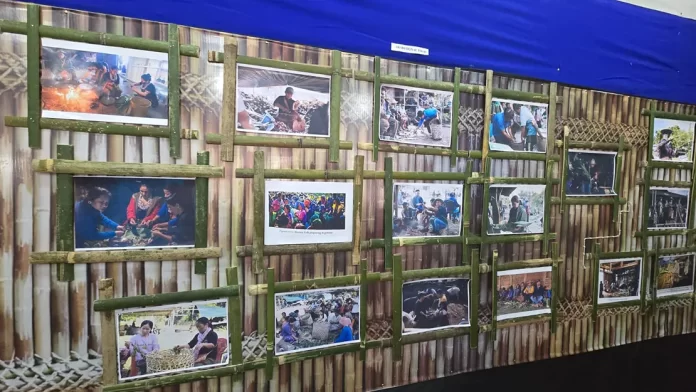Monday Musing
[Karyir Riba]
Reh – the most important festival of the Idu-Mishmi community of Arunachal Pradesh – is celebrated on the first three days of February every year. These three days are spent in great festivity, exchanging pleasantries, eating, drinking, merry-making with friends, family and other members of the community.
Reh is centrally celebrated at a larger level, and is also celebrated in every village there is. Men, women and children, all clad in their local traditional attire and ornaments, make a wonderful sight during this time.
It was not always the same though. Reh was celebrated centrally for the first time in the year 1967 under the leadership of late Ita Pulu. Before that, Reh was only performed individually.
So, how did Reh come into being, and when and why was is it performed for the very first time? Let’s go back in time and learn about the origin of this beautiful tradition of the Idu-Mishmi.
Before starting, I would like to convey my heartfelt gratefulness to igu Lonjo Mena for narrating the wonderful story, and his son Amithy Mena for translating even the most difficult words.
Once upon a time, a woman named Inny Asiliru left her baby in the care of Beka and Manu, before leaving to take care of some work in her field. Beka and Manu were deep water snakes who emitted a pleasant sound which she said would help keep her baby calm and help it go to sleep. So, after putting her precious baby in Beka and Manu’s guard, she left for her field.
On her return, Inny Asiliru was aghast to find her baby missing. Also missing were Beka and Manu. She had understood that the snakes had swallowed her baby and had hidden themselves in the deep waters.
Inny Asiliru was anguished and wanted to avenge her baby’s death; so she approached igu (shaman) Ambibri and requested him to perform mipi-ruhana as an act of revenge against Beka and Manu. Ambimbri was powerful. He was skilled at making weapons like a blacksmith. After accepting Inny Asiliru’s request, he started to work on luring Beka and Manu out of their hiding. He started making weapons for the process and kept on hammering at the weapon near the deep waters where Beka and Manu had hidden themselves. They were so annoyed by the noise that they sent Auro and Abro (local fish species) to Ambimbri. Ambimbri threw his atoli (weapon) on auro and abro. Next, they sent Asho and Aaya (local fish species) who were also attacked by Ambimbri with the leftover atoli. At last, Beka and Manu sent Aawupra (a type of catfish). Since Ambimbri had no atoli left, he held Aawupra to a rock and hammered on his head. To this day, the catfish have a flat head, unlike other fish species; auro and abro, who were hit with big-sized atoli, have larger scales, while asho and aaya have smaller scales as they were hit by the leftover small-sized atoli.
Ambimbri warned these fish to not interfere even as mediators because he was here to take Inny Asiliru’s revenge on Beka and Manu, and he would follow through. He continued making many weapons like aago, aato, jali aato, akhrih, ambota, aepesiyi (all local weapons), in order to not run out of weapons to use on his mission.
Clouds from Mudu lombibo, believed to be another world up above in shamanic terms, produced a stone believed to be an egg. From this egg came the chicken. Ambimbri caught Beka eating the chicken.
In Idu-Mishmi custom, when any person loses his life in a water body, it is said that he/she has been taken by Beka and Manu. It is believed that such snakes produce a hypnotic effect and attract their victims towards them before swallowing them. These victims do not see their predators under hypnosis; instead they see a beautiful world that draws them and makes them move towards their death on their own.
Ambimbri planned to use the same technique to lure Beka and Manu out. He performed ajime-laku (hypnotic method) to invite Beka and Manu to eat eggs. Inside these eggs, Ambimbri had hidden aepesiyi (weapons) which would kill the snakes when they swallowed the eggs. Till date, eggs are used to perform the mipi-si/mipi-ru during Idu-Mishmi funerals of people who have drowned or have been murdered.
Igu Ambimbri’s plan worked as both Beka and Manu fell into his trap and met with their death after swallowing the eggs. Ambimbri chopped up their bodies into pieces. The igu and his people wove some abru (local basket) to carry pieces of the meat before walking back home.
On their way, they met Apiju. Apiju was a slave caught by Inny-meta-ana to look after their fields. When Apiju saw the meat carried by Ambimbri and his people, he said he wanted to have some too. He was told that they wouldn’t be able to share as they were carrying it home from very far away; however, if he would go to Jahi-pelo (the riverside where Ambimbri had chopped up Beka and Manu), he would find a lot of the remaining meat. He could eat as much as he wanted, and also carry back in as much weight as he could bear. When Apiju told them that he did not know the way, he was told to follow the footprints left on the sand by Ambimbri and his people, and to follow the route they had made by cutting through the jungle and the markings they had made on trees for directions.
Apiju took their advice, reached the riverside and found the meat. He wanted to chop up Beka’s head and upon striking it open, found a pidi inside. A pidi can be described as a precious gemstone. So, Apiju took the pidi and brought it back with him to his rest house in the field that he was guarding. He placed it at the aethoti (a part in the front side) of the rest house/amo throko. That night, the amo throko was burned down to ashes. In his daze, Apiju was only able to snatch his pidi from the burning house before escaping. He then hid the pidi in a cave, but the cave collapsed too. He then hid his pidi under the banana grove. This led to the skeletal frame (or the hard core) of the banana tree to disappear. Hence, the banana tree has a soft stem not a true trunk. This was all happening because of the power of the pidi (Ibi edra). This was not realised by Apiju yet. The pidi was thereafter placed under the aamumbo tree (local name). The aaruto (cane) started climbing on the aamumbo. The aaruto became a source of income for Apiju as he learned to use it to make crafts, baskets, machete covers, and so on. The pidi started to bring in lopo (good fortune) for its owner. The aero (Mishmi teeta) became a valuable plant too after coming in contact with the pidi. The pidi had then spread its power of good fortune on the athu (a small variety of bee that gives honey). When the bear feasted on the athu, it became valuable too with its fur and gall bladder sought after.
Thereafter, the pidi was hidden under a mountain atop which lived the ambeyma (bees that give honey). The honey of the ambeyma became valuable,and so did the wax that came from its hive. The pidi was then hidden in the deeper side of the confluence of two rivers. This made fish valuable. When the aaro (otter) ate these fish, it became valuable too. Even today, the skin of aaro holds a lot of value.
Apiju hid the pidi in various locations with the intent of spreading and decreasing its power. He had also placed it in the sha arho (mithun area) and ala arho (musk deer arho). Both are of great value even today.
Finally, Apiju placed the pidi under his pillow. This led to him becoming seriously ill and bedridden. A number of igus (shamans) were called upon but none was able to cure his illness. Then he came upon igu Sineru, who told Apiju that placing the pidi under his pillow was the cause of his illness. He advised him to conduct something big which would bring him lots of honour and laurels, in order to ward off his illness. This conversation between Apiju and Sineru was eavesdropped by another igu named Ajiju. Ajiju took the opportunity to ask Apiju to allow him to perform the rituals of the event, which was accepted by Apiju. This event was named Reh. Even today, when an individual decides to conduct Reh, the igu approaches the individual to allow him to perform the rituals. This approach can also be made by a person who also aspires to conduct Reh. After being accepted, he presents the position to any igu of his choice. The process is called Rehgu si.
This betrayal angered Sineru. To disrupt the rituals, Sineru hid the souls of Apiju, igu Ajiju, Maselo (Idu-Mishmi divine entity), in a place which was filled with aju-apru (venomous snakes). This was a place that could not be traced out by anybody else. There, they had to kill these snakes for the dupo hala (feasting). Reh is performed to show respect to one’s relatives, especially to the embo or the maternal side of the family. Since Apiju, who was a slave and had no relatives, he offered the emehta (offerings) to the achumbo, aengambo (trees) calling them his embo and aniyu (immediate relatives).
This was how and why Reh was first conducted.
The aeho (rich people) now started talking and saying that the aeho should be the ones conducting Reh and not an aepo (slave). They opined that Reh should be a symbol of status, and should be conducted in grandeur. And the aeho, too, started conducting Reh.
They started looking for wives as they had important roles to play. Although single people have also conducted Reh, it is deemed important to have Menga-Apa, a combination of husband and wife, for the ritual. The igu blesses the couple with good health, prosperity and happiness. When a person decides to conduct Reh, he starts offering any kind of items, like fish, animals, rice, cash, bird, any such items, at a household where Reh is currently being conducted. This offering, known as ada, is recorded and is returned as adada to him/her during his/her Reh. An event called hathru is conducted a year before the actual Reh as a way of announcing to all the others and letting them know that the time for their adada has arrived.
Animals like pigs, mithuns, chickens and ducks are reared well before the Reh to be prepared to be used during the actual event. Fishing and drying the fish. Yupchi, preparation of yu (local alcohol) is also done 2-3 months ahead. This is done very neatly, and strictly does not allow females on their periods, widows or hunters, to participate.
Adaso is conducted five days ahead of the main Reh. During adaso, a deck (adacha) is built. All the ada (offerings) are brought to the adacha.
Reh is a five-day event during which relatives from near and far are invited to the Menga-apa’s (husband-wife conducting Reh) house to celebrate. The invitation is a short rope with knots tied on it. These knots indicate the date and day of the invite.
The first day (andropu) is when the igu starts conducting his chants and rituals. On the second day (aeyali), the sha pruchu or the biggest (main) mithun is sacrificed. Similarly, on the third day (eeli), the eli pruchu or the main pig is sacrificed. The first three days are dedicated to honour the guests.
The fourth day (arugo) is dedicated to the villagers and the menga-apa shows their gratitude for all the help by throwing a huge feast for them. The fifth day (aeto nu ha) is the last day, wherein the family feasts on chicken ashumbi (local dish) along with the villagers.
During the event, various types of meat (athapi) are offered to the guests and other attendees to be taken away with them.
The embo (maternal side of the family) and the wife’s side of the family receive emehta. Emehta can be described as gifts which can be in cash or in kind. The menga’s clan does not receive any emehta.Sisters of the menga, or sons-in-law of the menga, have to offer aghite to the menga-apa. Aghite can also be in cash or kind. Eliso tathu (pork) or dried fish is given in return of their aghite.
In totality, Reh is indeed a beautiful tradition that brings relatives together for a joyous celebration. It is considered a mark of highest honour to be able to conduct Reh at least once in a lifetime.






